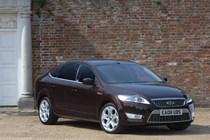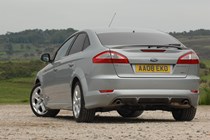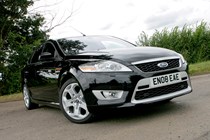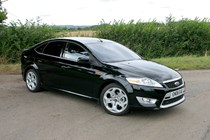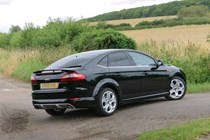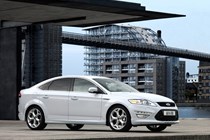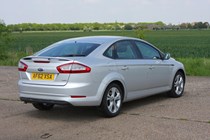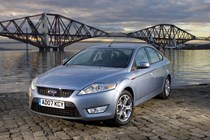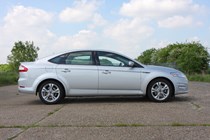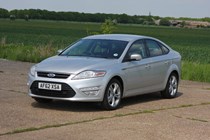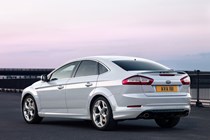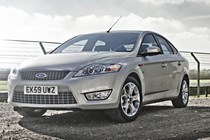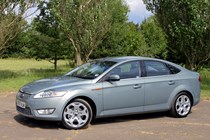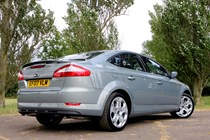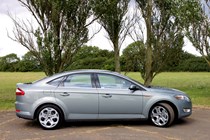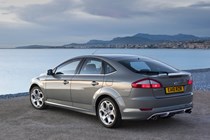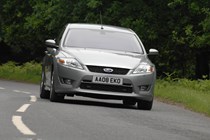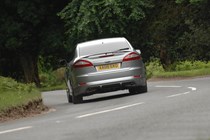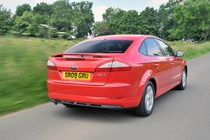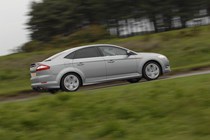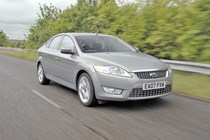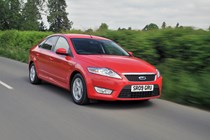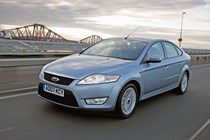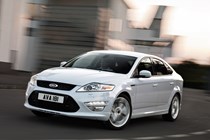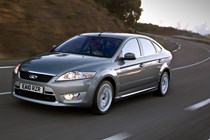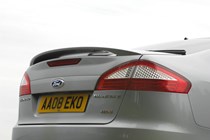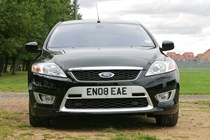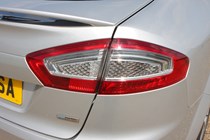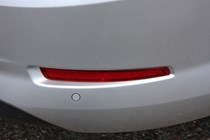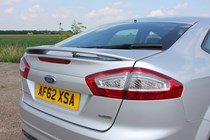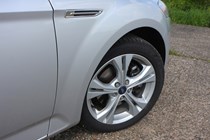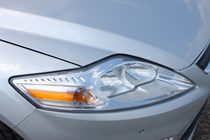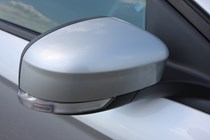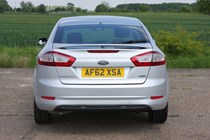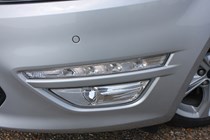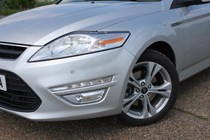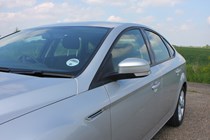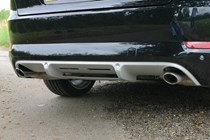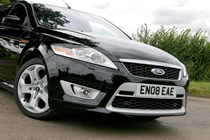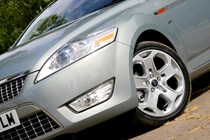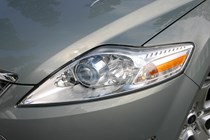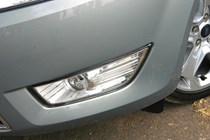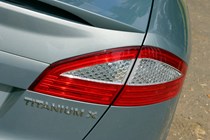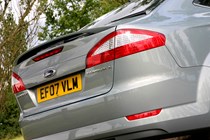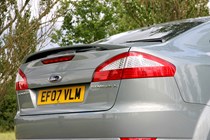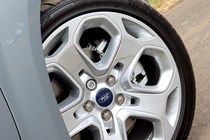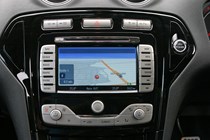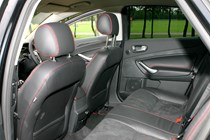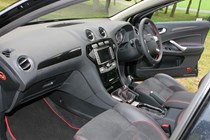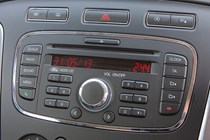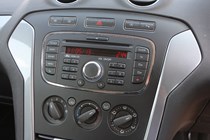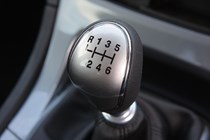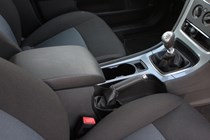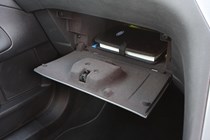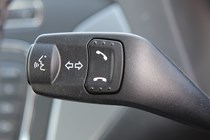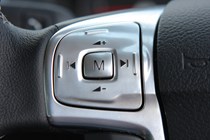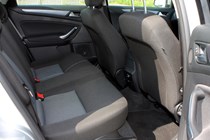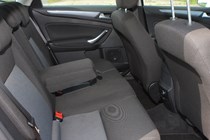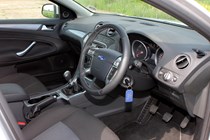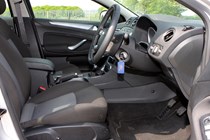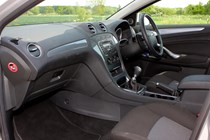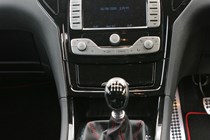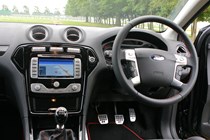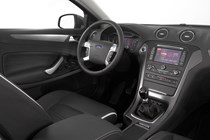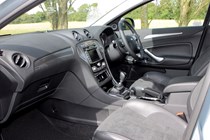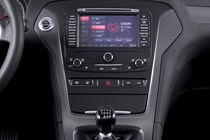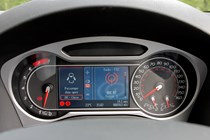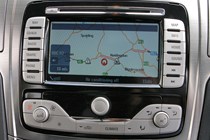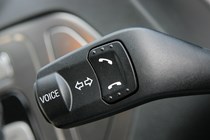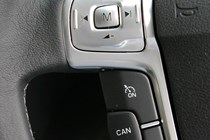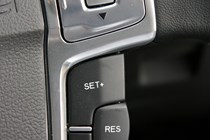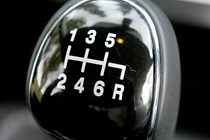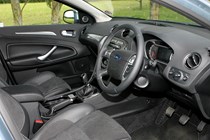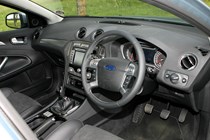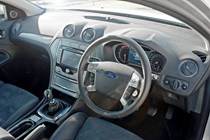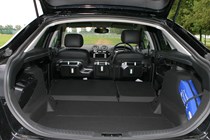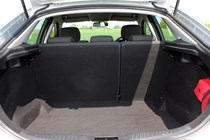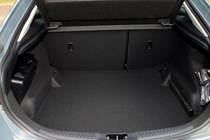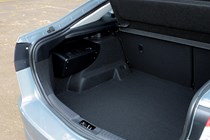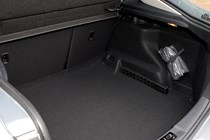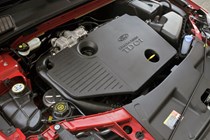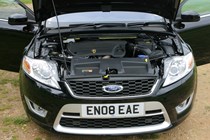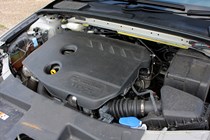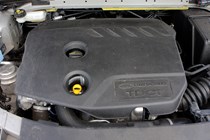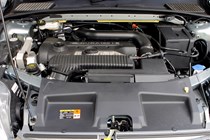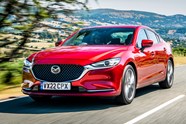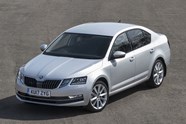Ford Mondeo Hatchback (2007-2014) review
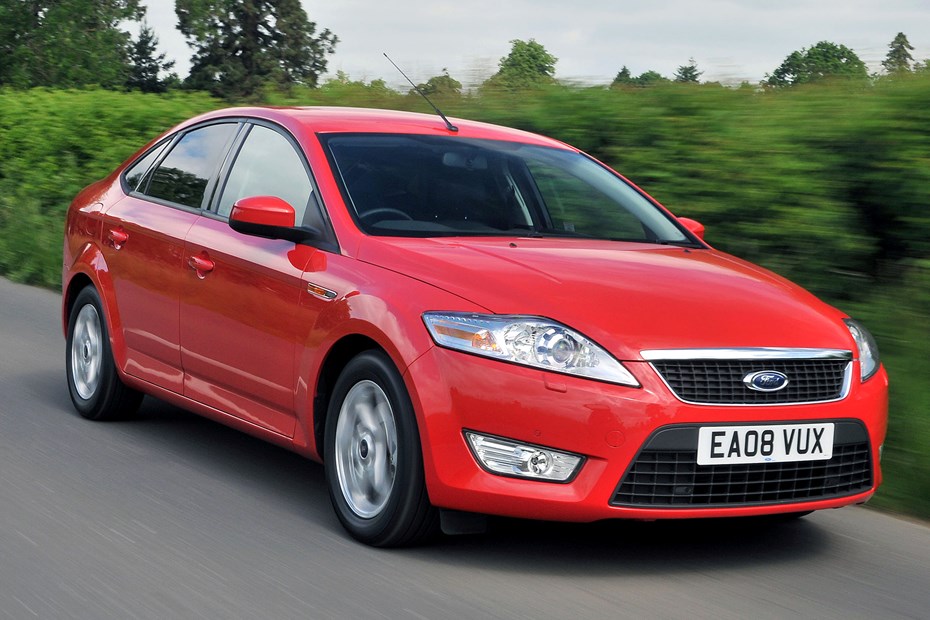
At a glance
| Price new | £15,820 - £29,780 |
|---|---|
| Used prices | £400 - £6,614 |
| Road tax cost | £20 - £430 |
| Insurance group | 12 - 28 |
Get an insurance quote with

|
|
| Fuel economy | Not tested to latest standards |
| Range | 462 - 1032 miles |
| Number of doors | 5 |
| View full specs for a specific version | |
Available fuel types
Petrol
Diesel
Alternative fuel
Pros & cons
- Huge interior
- Incredibly comfortable
- Great to drive
- May be too large for some
- No ULEZ-compliant diesel
- Powershift automatic is unreliable
Ford Mondeo Hatchback (07-14) rivals
Overview
Designed from the outset to bring the large family car firmly into the 21st century, the third generation Ford Mondeo Hatchback is one of the largest, most comfortable, and best equipped used cars you can buy for the money, with spec and engines to suit most buyers.
The entry-level cars are the best large hatchbacks you can buy used; far superior to contemporary Vauxhall Vectras and considerably more reliable than the Renault Laguna. Overlook the Ford badge and the top-range models rival prestige cars such as the BMW 3 Series, Audi A4 and Mercedes-Benz C-Class in terms of build quality and driving experience.
As the oldest Ford Mondeo Mk4s are approaching two decades on the road there’s plenty of wear and tear to take into account before searching through Britain’s cars for sale, but the body and interior can generally be cleaned up to a very presentable standard. You’ll find features such as blind-spot monitors, lane departure warning and automatic headlight dipping on later models, as well.
Used Ford Mondeo Mk4 buying guide
Prices are at rock bottom for this generation of Mondeo, making it something of a bargain for a well equipped, safe large hatchback. This low value means that many of them are neglected, so you may need to budget more for upgrades and repairs during your ownership – but keep reading to find 10 of the easiest pitfalls to avoid.
Get a good one and you’ll have a tidy handling and practical family car with good motorway refinement and surprisingly low running costs, particularly if you go for the post-facelift models from 2010 onwards (easily identified by the LED lights and redesigned grille).
Which used Ford Mondeo Mk4 is best?
We would lean towards the 2.0-litre EcoBoost petrol if doing a high mileage with a mix of dual-carriageway and cities, the 2.2-litre TDCi if you primarily do motorway miles, and the 1.6-litre EcoBoost petrol if you need to drive around ULEZ or clean air zones. If you want an automatic model look for the Durashift six-speed automatic rather than the Powershift. Spec-wise, simply get the best you can find – but Titanium and Titanium X usually have enough equipment to avoid feeling sparse.
Ford Mondeo Mk4 known faults and common problems
1. Know your diesels. Ford Mondeo 1.6, 1.8, 2.0 and 2.2 TDCi
There are three different types of diesel engine used in the Ford Mondeo Mk4, the oldest being the 1.8-litre (known as DLD-418) which is a modified Endura-D with a wet timing belt. This has a 125,000/10-year service interval officially, but it often fails prematurely and most garages recommend at least checking it at 65,000 miles. The 1.6-litre is the (DLD-416) is the familiar design shared with Volvo, Peugeot, Citroen, Mazda and many other brands, and the 2.0 and 2.2-litre TDCi are the DW type also shared with Peugeots.
Two important points to remember when looking at a used Ford Mondeo Mk4 diesel, and a caveat:
- Mondeo service indicators monitor oil quality – which includes if diesel has contaminated the oil, not just if it’s due a change. If it says a service is due, it probably means it – look for cars that have been serviced ahead of the intervals.
- The Ford Mondeo Mk4 does not use diesel additive fluid, unlike Volvo, Peugeot etc. cars that share these engines. There is no service requirement to change this fluid, and it’s not why your car is complaining about the DPF being full.
- When these cars were new, garages would rather sell owners a ‘DPF delete’ and a remap than actually replace a full particulate filter. The MOT test was revised to cover DPF removal; presence of the filter is part of the test and removal is a failure. A remapped car may not show the obvious warning light, but it could fail a smoke test.
Excessive fuel smell after a run may also indicate DPF regeneration is failing, which dilutes the oil. Ford’s status system will tell drivers if the car needs to regenerate the DPF in the main instruments, but at high mileages even a well maintained car may need it replacing.
2. 1.6-litre TDCi – turbo failures, DPFs
Common problems include injector leaks, clogged diesel particulate filters and EGR valves, and the 1.6-litre is ‘notorious’ for turbo failure in most installations. Listen for tapping or clicking at the top of the engine and look for wet/oily deposits around the injectors and breather hoses, and on the test drive look in the mirror for excessive smoke under hard acceleration. Fuel smells can be down to leaking return pipes but may be due to excess fuel delivery, leaking injectors and consequential oil contamination.
Visually inspect all hoses and pipes for cracking and splits even if the car is running perfectly. Pre-emptively replacing these can avoid big bills later.
In most places where this engine is used the DPF is a service item, intended to be replaced at 75,000 miles. Ford initially said 100-125,000 miles, and unlike most installations the Mondeo does not use DEF (diesel exhaust fluid, also known as Eolys or PAT).
2. 1.8-litre TDCi (Lynx) – wet belt problems
Some users recommend converting the 1.8 TDCi back to the original timing chain design, but it’s noisier and less efficient than the improved timing belt in oil Ford introduced for the Mondeo Mk4. Check the oil on the dipstick and sniff for diesel fumes, as fuel contamination of the oil is the most likely cause of premature belt failure.
3. 2.0 and 2.2-litre TDCi – leak off, fuel pump and injectors
In addition to the diesel particulate filter problems commonly associated with more recent diesel engines, the 2.0-litre and 2.2 TDCi DW10/DW12 can suffer a variety of problems related to the fuel injectors and pump. Leak-off pipes can introduce air into the system causing poor running and misfires, and the injector seals themselves can leak. Look for greasy, sooty deposits near the pipework on top of the engine after removing the plastic cover. You may also see exhaust/fumes when the engine is running.
4. Dual-mass flywheel (manual and Powershift automatic)
The Mondeo Mk4 is a big, heavy car often fitted with torquey diesel engines, so naturally there’s a dual-mass flywheel trying to smooth out the interface between unstoppable force and immovable object. Feel for juddering when pulling away in a similar test to a worn clutch – if it’s accompanied by a rumble or squeak/yelp sounds suggests quite an advanced state of wear for the DMF. Likewise, vibration at speed that disappears when you dip the clutch and let revs fall is a good indicator.
The Powershift automatic gearbox is a dual-clutch system and also includes a dual-mass flywheel. While juddering and snappy or delayed changes are more likely to be purely a gearbox issue, vibration at cruising speed or grumbling noise when pulling away are a good reason to move on to the next car on your list. Repairs to a Powershift transmission car invariably incur four-figure bills. If a Powershift car is anything other than smooth and well-behaved with a history of servicing at three-year/37,500 mile intervals, we’d avoid it.
5. Conventional six-speed automatic (Durashift)
2.2-litre diesels, 2.3 litre automatic, and some older 2.0-litre models may have a six-speed automatic that isn’t Powershift. This is an Aisin-Warner gearbox which Ford calls AWF21, and uses a conventional torque convertor. Look in the service history of higher-mileage cars for a receipt for fluid and filter changes around 40-70,000 miles – there’s no specified interval from Ford but as a rule the gearboxes last longer if given regular maintenance. The Durashift has a dipstick on the 2.3 making it much easier to check oil condition.
6. Coolant checks – all models
Ford has had a few issues around cooling systems, but the Mondeo is quite good. Look for leaks from the thermostat housing (follow the radiator hoses to the engine), the heater pipes (hoses at rear of engine bay, check for damp carpets in the footwell and a sweet smell when the fan is running) and for bubbles with the expansion tank cap off and running the engine from cold, up to temperature.
If it looks like it has been topped up recently (spills, fresh coolant despite neglect elsewhere) be aware that the automatic gearbox coolers, and on diesel models, the EGR cooler can leak coolant into other places. The EGR cooler is particularly concerning.
7. Keyless entry and pushbutton start
Check that the car has the original keys, and that they work – batteries are easy to replace so there’s no excuse for a dead remote. Keyless security means the Mondeo can be effectively immobilised by faulty modules and keys (or bad copies). Some cars have an optional push-button start.
8. Econetic stop/start problems
The Econetic models have lower emissions due to stop/start technology. When test driving make sure the car is warmed up and does not have the heated rear window or other heavy power drains, and see if the engine cuts out at stops and restarts cleanly.
If it doesn’t the battery may be due for replacement, it requires an AGM or EFB battery; it’s also possible that the owner has disconnected the module, however – look for a white box below the steering wheel with a a loose plug and empty connector.
9. Radio and infotainment
The Mondeo’s stereo is a bespoke fit that leaves plenty of room for upgrades, so if the standard one has gone and been replaced with a double-DIN touchscreen consider it a bonus. The original is prone to losing the DAB radio and failure of the CD mechanism.
Facelifted cars have more sophisticated options, but the main hazard when upgrading is ensuring you have the right looms and adaptors, and bear in mind the standard parking sensors beep through the radio.
10. Steering and suspension
The Mondeo Mk4 has a sophisticated rear suspension setup, so check all four wheels for uneven wear. Misalignment can indicate damage or just worn bushes – if there’s no clonk or rattle, and the rear tyres are scrubbed or unevenly worn it may indicate accident damage. Front suspension is simpler, but very heavy-duty – control arms and bush wear can be felt as pulling or wandering.
Power steering is prone to leaks from the reservoir – check the MOT history to see if the steering rack and pipework have shown problems before – and strut top mounts can fail, with heavy steering and crunching sounds being the first indication they’re past their best. Replacement is usually straightforward but it’s worth making sure the wheelbearings and ABS rings are in good condition before having work done on the front suspension.
What’s the Ford Mondeo Mk4 like to live with?
Over the next few pages, we’ll review each aspect of the 2007-14 Ford Mondeo, taking into account its practicality, comfort, fuel economy and performance. If you’re short on time, you can also skip to our verdict page to see if we recommend the Ford Mondeo Mk4 as a good used car.



